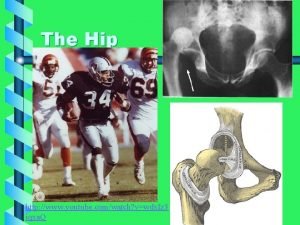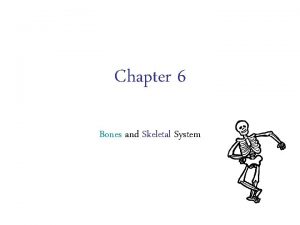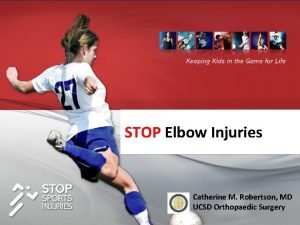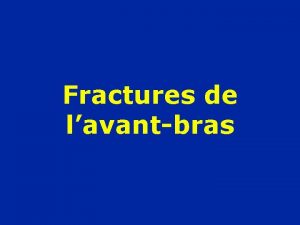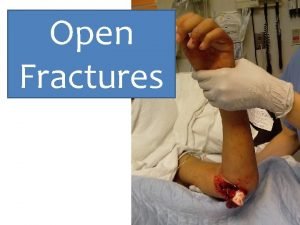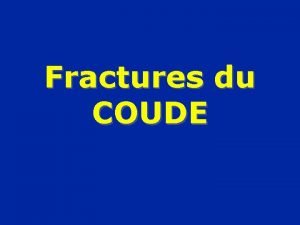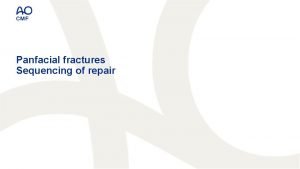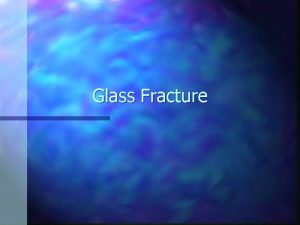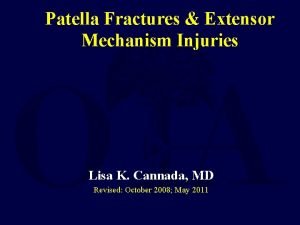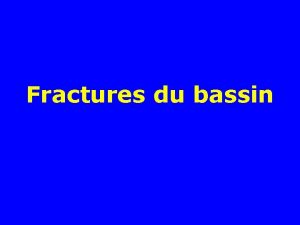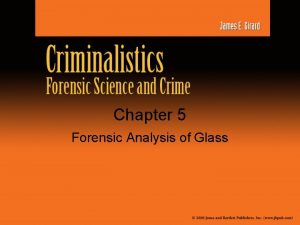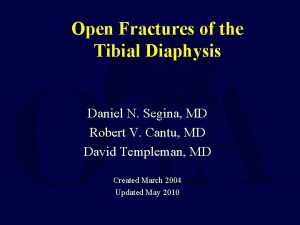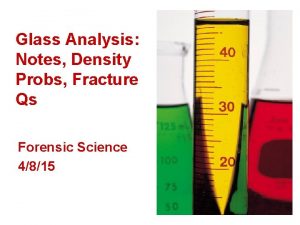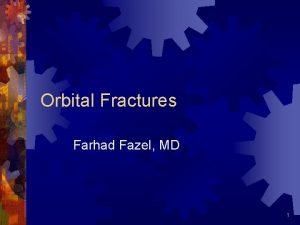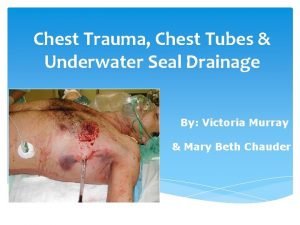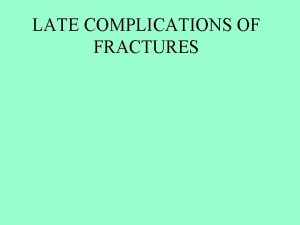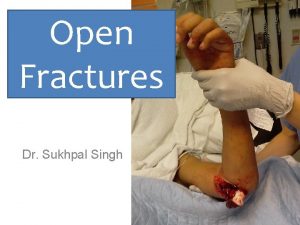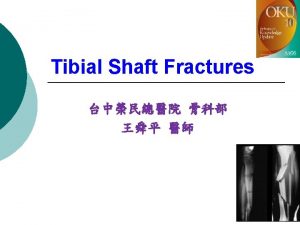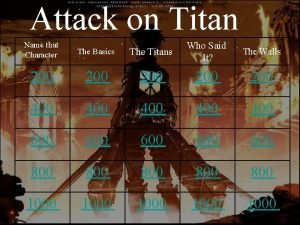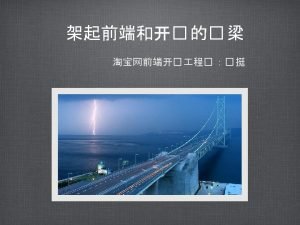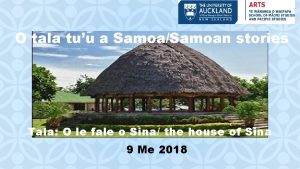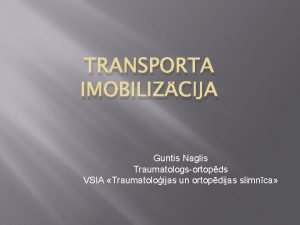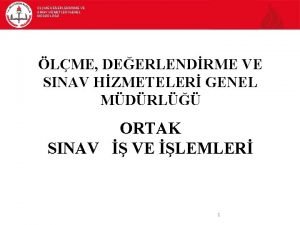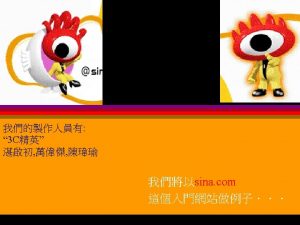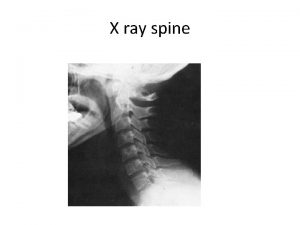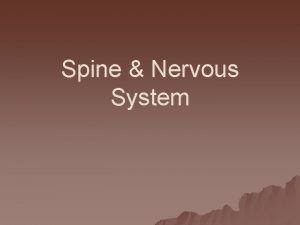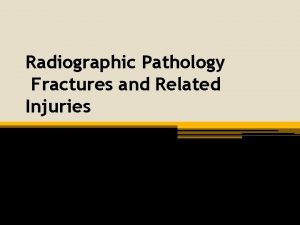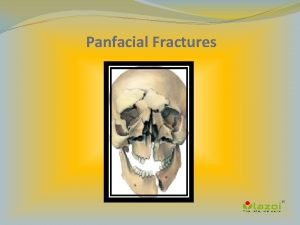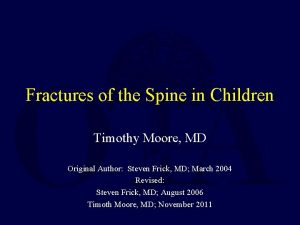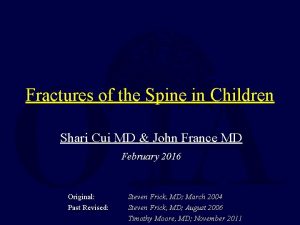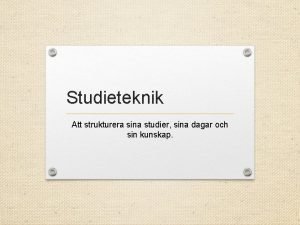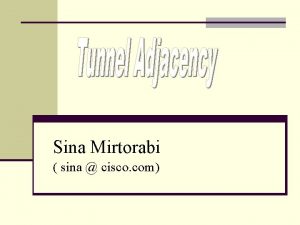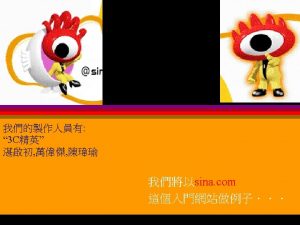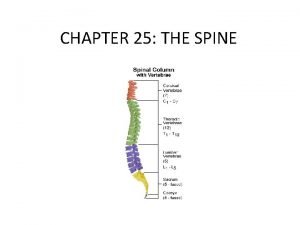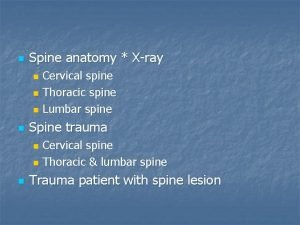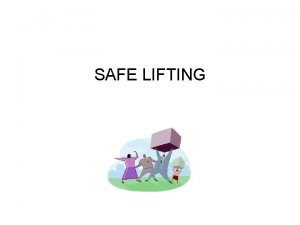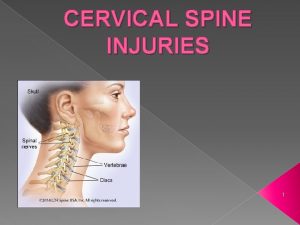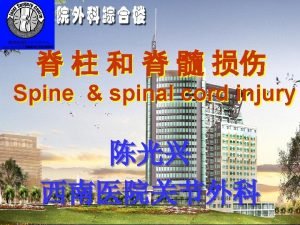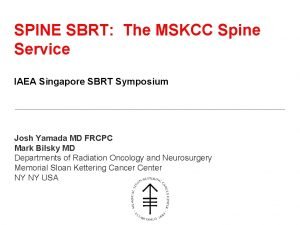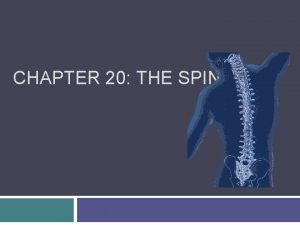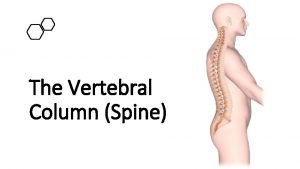Fractures of the Spine in Children MD SINA





























- Slides: 29

Fractures of the Spine in Children , MD SINA HOSPITAL Vahid Farsio

Important Pediatric Differences Anatomical differences n Radiologic differences n Increased elasticity n

Anatomy – C 1 n n 3 ossification centers at birth – body and 2 neurocentral arches Neurocentral synchondroses (F) fuse at about 7 years of age n. Copley. Cervical spine disorders in infants and children. J Am Acad Orthop Surg. 1998; 6: 204.

Anatomy – C 2 n n 4 ossification centers at birth – body, 2 neural arches, dens Neurocentral synchondroses (F) fuse at age 3 -6 years Synchondrosis between body and dens (L) fuses age 3 – 6 years Thus no physis / synchondrosis should be visible on open mouth odontoid view in child older than 6 years n. Copley. Cervical spine disorders in infants and children. J Am Acad Orthop Surg. 1998; 6: 204.

Anatomy – Lower Cervical Vertebrae C 3 – C 7 n Neurocentral synchondroses (F) fuse at age 3 -6 years n Ossified vertebral bodies wedge shaped until square at about age 7 n. Copley. Cervical spine disorders in infants and children. J Am Acad Orthop Surg. 1998; 6: 204.

Epidemiology of Spinal Trauma in Children n Spinal injury is rare in children n Pediatric vertebral injuries occur 60 -80% of the time in the cervical region (30 -40% of all vertebral injuries in adults) n Overall incidence of spinal injury in children is 1 -2% n Motor Vehicle Accidents are the leading cause of pediatric SCI (60% of cases)…with falls and sports injuries (football and diving) thereafter n M: F ratio of 2: 1

n Pediatric vs. Adult Spine Anatomy ……. . Not just little adults! Children younger than 8 yrs are more susceptible to C- Children younger than 8 yrs are more susceptible to Cspine injuries because; n Larger head to body proportion Higher fulcrum……. “point of maximal mobility” (C 2 -3 at birth, C 3 -5 at 8 -12 yrs old to C 5 -6 at 12 yrs old and adults) n Weaker cervical musculature n Increased ligamentous laxity leading to greater mobility of the cspine n Immature joints and Ossification centers n Horizontal facet joints that facilitate sliding of the upper C-spine n Spinal columns are more elastic than the spinal cord (tolerating n

Key History and PE Components n History n n n Cause…. MVA, Sports (Football/Diving), Falls Mechanism…. . Hyperflexion (Clay shoveler’s or Teardrop Fx’s), hyperextension (Hangman’s Fx), Rotational (Jumped Facets), Compression or axial loading (Jefferson/Burst Fx) Symptoms…. . Numbness, tingling, or weakness during any time since accident even if resolved Predisposing conditions…. . 15% Down’s Syndrome pts have atlantoaxial instability, Achondroplasia (Cervicomedullary Junction stenosis) Physical Exam n n n Testing for motor or sensory deficits and levels if present DTR’s and rectal tone High index for Multisystem trauma (40% of cases have associated intrabdominal injuries)

C Spine Immobilization for Transport in Children n n Large head will cause increased flexion of C spine on standard backboard Bump beneath upper T spine or cutout in board for head to transport child with spine in neutral alignment

Imaging Evaluation of Spine Injuries n Are Xrays indicated? n NEXUS Study Criteria n Lateral, AP and Odontoid view n Flexion-Extension views n CT C-spine n MRI

l l l n. Young Child n. Mature anterior wedging of vertebral bodies horizontal alignment of facet joints Children prone to anterior dislocation

Alignment Pseudosubluxation n n 24% C 2 on C 3 14% C 3 on C 4 (Age <7 years) n Swischuk’s line: posterior arch of C 1 to C 3 – should come within 1 mm of post arch of C 2

C 2 -3 Pseudosubluxation n Look for significant prevertebral soft tissue n. Shaw. Pseudosubluxation of C 2 on C 3 in polytraumatized children: Prevalence and significance. Clin Radiol 1999; 54: 377.

Dens n n n Predental space – allow up to 5 mm in young children Subdental synchondrosis lucency at base of dens Dens fuses with body of C 2 between ages 4 - 6 years A thin lucency may be appreciable on the lateral view for many years (50% up to age 11) May have ossification centre at tip of dens os terminale

Prevertebral Soft Tissues n n Allowable thickness changes with age In general: n n n Above glottis: ½ vertebral body Below glottis: 1 vertebral body Often falsely thickened 2° to neck flexion (big occiput) or expiration

n. Optimal if pt neck extended (and x ray taken at END inspiration – less false +).

Cervical Spine Injuries from Birth Trauma n Can occur n Upper cervical injuries may be a cause of perinatal death n. Newborn with C 5/6 fracture dislocation

Os Odontoideum n Usually asymptomatic n Pain , mylopathy instability n. Fielding. Os odontoideum. J Bone Joint Surg Am 1980; 62: 376.

Atlanto-Occipital Dislocation n n 2. 5 x more common in children than adults Due to small occipital condyles and horizontal atlanto-occipital joints Suspect if distance between occipital condyles and C 1 is > 5 mm at any point Usually have ++ soft tissue swelling


Dens Fracture n Suspicious for dens fracture: n n n widening of the synchondrosis anterior tilting of the odontoid Believed to have high miss rate – can lead to chronic problems

Hangman’s Fracture n. The hangman's fracture i n. Pseudosubluxation !!

Spinal Cord Injury Without Radiographic Abnormality SCIWORA n n n Defined as traumatic myelopathy in the absence of findings on plain radiographs, flexion-extension radiographs and cervical CT scan mechanism is acceleration-deceleration or rotation injury 30 -50% delayed onset of neurologic deficits from 30 mins-4 days n MRI should be done n require immobilization n Mild SCIWORA : Cervical cord neurapraxia

Thoracic Spine Fractures n Less common spinal fracture in children than in more mobile regions n Child abuse in very young n. Slotkin. Thoracolumbar spinal trauma in children. Neurosurg. Clin. N. Am. 2007; 18: 621.

Thoracolumbar Junction Injuries T 11 -L 2 Classically lap-belt flexion-distraction injuries n Chance fractures and variants n High association with intraabdominal injury (50 -90%) n Neurologic injury infrequent but can occur n n. Arkader. Pediatric chance fractures: a multicenter perspective. J Pediatr Orthop.

Seatbelt Injury Classification n. Rumball. Seat-belt injuries of the spine in young children. J Bone Joint Surg Br. 1992; 74: 571.

4 year Lap Belt Intraabdominal Injuries, Paraplegic

Lumbar Apophyseal Injuries Slipped Apophysis n Compression-shear injuries n Same age group as SCFE n Typically adolescent males, inferior endplates of L 4 or L 5

Thank You
 Ilioposas
Ilioposas Types of fractures with pictures
Types of fractures with pictures Bone cancer fractures
Bone cancer fractures Irving olecranon bursitis
Irving olecranon bursitis Fracture bois vert
Fracture bois vert Classification of open fractures
Classification of open fractures Supracondylienne
Supracondylienne Acetabulum ossification
Acetabulum ossification Panfacial fractures sequencing
Panfacial fractures sequencing Weber classification
Weber classification Radical fracture glass
Radical fracture glass Lisa kasman
Lisa kasman Fracture de malgaigne bassin
Fracture de malgaigne bassin Types of glass fractures
Types of glass fractures Classification of open fractures
Classification of open fractures Types of glass fractures
Types of glass fractures Canthatomy
Canthatomy Chest tube water seal vs suction
Chest tube water seal vs suction Perkins timetable of fracture healing
Perkins timetable of fracture healing Dr sukhpal singh
Dr sukhpal singh Ao classification of fractures
Ao classification of fractures Avicena (980 - 1037)
Avicena (980 - 1037) Attack on titan names
Attack on titan names Weibo
Weibo Principios del sina
Principios del sina Tala faasamoa
Tala faasamoa Uri ng pangngalan pambalana
Uri ng pangngalan pambalana Kausveida nestuves
Kausveida nestuves Lme sina
Lme sina Sinä tunnet herra minut
Sinä tunnet herra minut
